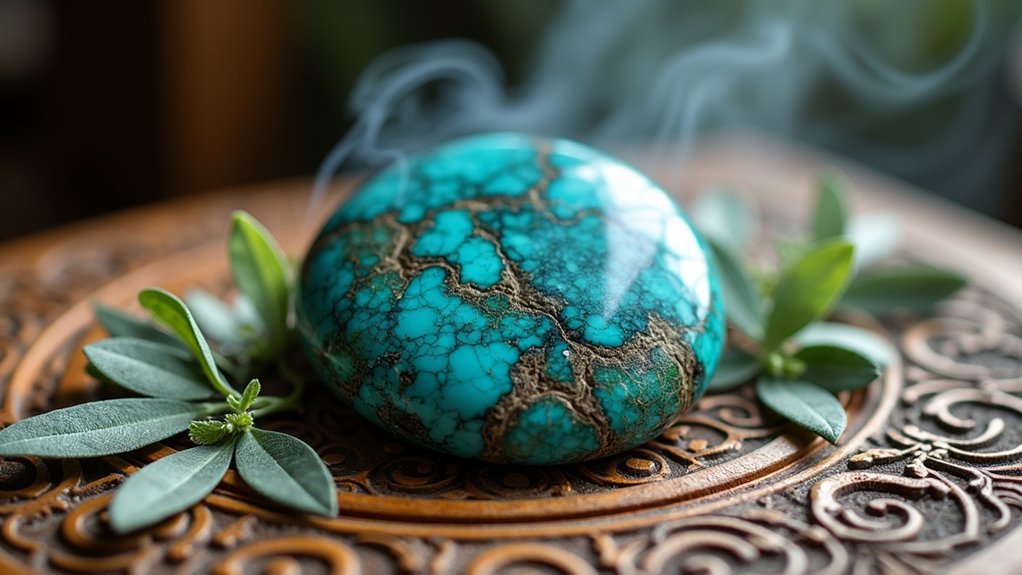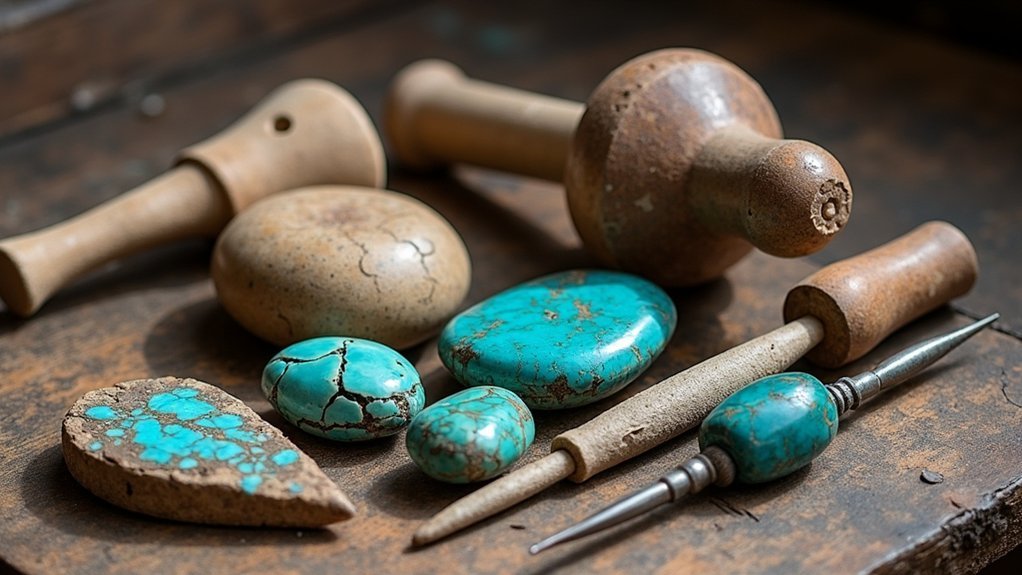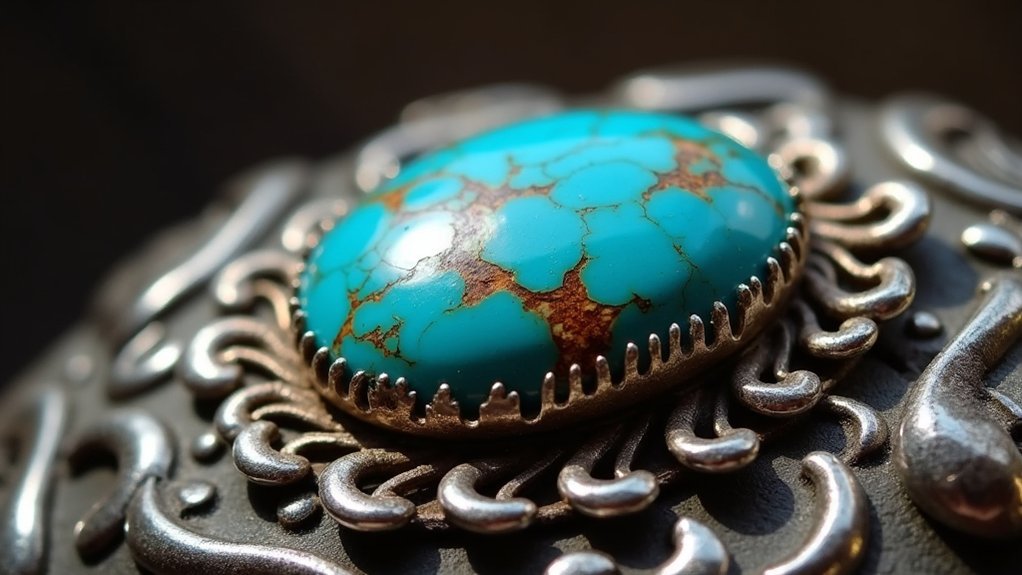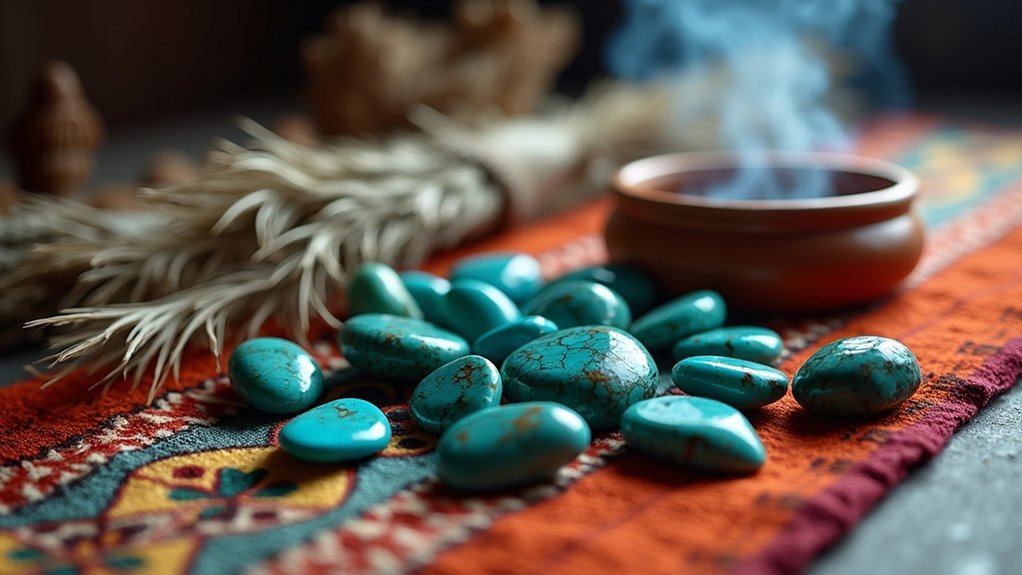You’ll find that Native American artisans developed sophisticated turquoise crafting methods over centuries, using hand tools like stone hammers and bone awls to extract stones from over 200 mining sites across the Southwest. They employed bow drills for precise hole-making, natural abrasives like sand and sandstone for polishing, and sacred ceremonial practices to preserve the stone’s spiritual energy. These techniques were passed down through generations via oral traditions and hands-on mentorship within tribal communities. Explore further to uncover the intricate details of these time-honored practices.
Sacred Origins of Turquoise in Native American Culture

While many gemstones throughout history have held cultural significance, turquoise stands apart as one of the most spiritually revered stones in Native American traditions, where it’s been treasured for millennia as a sacred bridge between earthly and celestial domains.
Few stones command the spiritual reverence that turquoise holds in Native American culture as a sacred celestial bridge.
You’ll discover that turquoise’s sacred origins stem from creation myths, particularly the Navajo belief that deities gifted this precious stone to humanity for protection and prosperity.
Across tribes, you’ll find turquoise woven into rituals and ceremonies, each culture attributing unique spiritual significance to its presence. The Apache connected it to rain and hunting success, while Acoma Pueblo used it for attractiveness and love.
In Hopi traditions, turquoise represents strength and security in their sacred practices.
Traditional Mining Methods and Stone Selection
Long before Spanish conquistadors set foot in the Americas, Native American miners had already perfected sophisticated techniques for extracting turquoise from the earth, establishing over 200 mining sites across the Southwest during more than a millennium of continuous operation.
You’ll find these traditional mining methods remarkably effective for their time. Miners used simple hand tools like digging sticks and stone hammers to access surface deposits and shallow pits throughout the Southwestern United States.
They’d target areas with copper deposits, knowing turquoise often occurred nearby.
Stone selection involved careful consideration of cultural beliefs:
- Blue turquoise – Associated with masculinity and spiritual power
- Green turquoise – Connected to femininity and earth energy
- Mount Chalchihuitl specimens – Prized for exceptional quality across tribes
The quality of the turquoise depended heavily on mineral composition, making expert selection essential.
Ancient Tools and Implements for Turquoise Working

You’ll discover that ancient artisans developed sophisticated stone grinding techniques using materials like sandstone and other natural abrasives to shape and polish turquoise into beautiful ornaments.
These craftspeople created hand-carved mining tools from bone, wood, and stone that allowed them to extract turquoise from deposits and work it into intricate designs.
The Hohokam culture exemplifies this mastery, as they used simple grinding implements over 2,300 years ago to transform raw turquoise into stunning beads and decorative pieces.
Stone Grinding Techniques
Although turquoise’s relative softness made it workable, ancient Native American artisans couldn’t simply carve it with their hands. They developed sophisticated stone grinding techniques using harder materials like granite and quartzite to shape and polish their precious stones.
These Native American artisans created stunning turquoise jewelry through careful abrasion and pressure, employing back-and-forth motions to achieve smooth surfaces and refined contours.
The Hohokam culture perfected these methods over 2,300 years ago, creating intricate designs through precise material removal. Their grinding process involved three essential elements:
- Pitted stones – Primary grinding tools for shaping beads and pendants
- Natural abrasives – Sand and crushed stone enhanced manipulation capabilities
- Controlled pressure – Strategic force application achieved desired forms and finishes
Archaeological evidence confirms these techniques produced exceptional craftsmanship in ancient jewelry-making.
Hand-Carved Mining Tools
Before ancient artisans could apply their grinding techniques, they first had to extract turquoise from deep within the earth using ingeniously crafted hand tools. You’ll discover that these hand-carved mining tools weren’t just functional implements—they represented generations of accumulated wisdom about geology and terrain.
Ancient Native American cultures created picks and hammers from sturdy stones, perfectly designed for breaking apart mineral-rich rock formations. You’d find that artisans also fashioned specialized chisels and grinding tools from wood, stone, and bone to shape extracted turquoise into ceremonial artifacts.
| Tool Type | Primary Material |
|---|---|
| Picks | Stone |
| Hammers | Stone |
| Chisels | Bone/Stone |
| Grinding Tools | Wood/Stone |
| Extraction Tools | Mixed Materials |
Archaeological evidence reveals these tools held profound cultural significance beyond their practical applications.
Stone Shaping and Cutting Techniques
You’d discover that ancient artisans relied on traditional grinding methods using harder stones and abrasive materials to gradually shape turquoise into desired forms.
Many tribes incorporated sacred cutting rituals into their crafting process, believing spiritual ceremonies enhanced both the stone’s power and the artisan’s skill.
Through hereditary crafting wisdom passed down across generations, you’ll find that families preserved specific techniques and closely guarded secrets for achieving the finest cuts and most intricate designs.
Traditional Grinding Methods
When you examine ancient turquoise artifacts, you’ll discover that Native American artisans developed sophisticated grinding methods using stone tools to shape and polish this prized mineral into stunning jewelry pieces.
These traditional grinding methods required exceptional skilled craftsmanship, with artisans spending countless hours perfecting their shaping techniques.
The Hohokam culture mastered these processes over 2,300 years ago, creating intricate designs that showcase their advanced abilities.
You’ll find that artisans utilized grit stones and harder minerals to transform raw turquoise stones into smooth, refined forms.
Essential grinding techniques included:
- Surface polishing – Using abrasive materials to achieve flawless finishes
- Cylindrical bead formation – Grinding small pieces into uniform shapes for stringing
- Precision drilling – Creating holes for assembling complex jewelry pieces
Sacred Cutting Rituals
As you explore deeper into ancient turquoise working methods, you’ll uncover the profound spiritual dimension that governed every aspect of stone cutting among Native American tribes.
Sacred cutting rituals began with specific ceremonies and prayers honoring the stone’s spirit before any turquoise shaping commenced. You’d witness artisans using handheld tools made from quartz or obsidian, treating each cut with reverence to preserve the stone’s protective energy.
Cultural traditions varied notably between tribes – Zuni artisans excelled at intricate mosaic inlay work, while Navajo jewelers focused on cabochon-style cuts showcasing natural beauty.
The spiritual significance meant improper treatment could disrupt the stone’s energy, so craftsmen approached their work with extraordinary care, passing down these sacred techniques through generations.
Hereditary Crafting Wisdom
These sacred practices formed the foundation for hereditary crafting wisdom that master artisans carefully guarded and passed down through bloodlines.
You’ll discover that Native American artisans developed sophisticated traditional methods over millennia, creating turquoise jewelry that embodies their cultural heritage.
Each family’s techniques became closely protected secrets, guaranteeing their survival through generations.
The transmission of this hereditary crafting wisdom involved three essential elements:
- Hand-selecting apprentices – Master craftsmen chose family members who demonstrated natural aptitude and spiritual connection to the stones.
- Years of careful observation – Apprentices spent decades watching before attempting intricate inlay work themselves.
- Ceremonial knowledge transfer – Sacred cutting rituals accompanied technical instruction, preserving both spiritual and practical wisdom.
This careful preservation guaranteed that each generation maintained the highest standards of craftsmanship.
Polishing Methods Using Natural Materials
While modern lapidary equipment didn’t exist centuries ago, Native American artisans mastered the art of polishing turquoise using materials provided by nature itself. You’d find these craftspeople utilizing sand, sandstone, and emery to achieve remarkably smooth finishes through patient rubbing techniques. These polishing methods enhanced the stone’s natural luster while preserving its spiritual significance.
Different tribes developed distinct craftsmanship styles – the Navajo and Zuni each perfected unique approaches that reflected their cultural heritage.
You’ll notice how artisans combined polishing with traditional shaping and drilling methods, maintaining each stone’s authentic character. Their reliance on natural materials demonstrated profound respect for earth’s gifts, amplifying the spiritual connection between creator and creation in every finished piece.
Drilling and Perforation Practices

You’ll face significant challenges when drilling turquoise due to its variable hardness, which ranges from 5-6 on the Mohs scale and can cause your tools to slip or crack the stone.
You must master traditional tool-making methods using harder materials like flint, quartzite, or bone to create effective drill bits that won’t dull quickly against turquoise’s tough surface.
You’ll need to develop precise bead hole sizing techniques that account for the stone’s tendency to chip, requiring you to work slowly and apply consistent pressure from both ends.
Stone Hardness Drilling Challenges
Ancient artisans faced significant challenges when drilling turquoise due to the stone’s deceptive softness, which registers only 5 to 6 on the Mohs Hardness Scale yet requires precise techniques to prevent cracking or shattering.
You’ll find that despite turquoise’s relatively soft composition, creating beads demanded extraordinary skill and patience from Native American craftspeople.
The drilling process presented three major obstacles:
- Pressure control – Too much force would crack the stone, while insufficient pressure wouldn’t penetrate effectively.
- Tool limitations – Primitive wooden and stone implements required constant adjustment and replacement during extended work sessions.
- Surface stability – The stone’s softness made it difficult to maintain steady drilling positions without slippage.
These challenges made each successfully drilled turquoise bead a demonstration of the artisans’ expertise and cultural dedication.
Traditional Tool Making Methods
Before sophisticated metal tools existed, Native American artisans crafted ingenious drilling implements from materials readily available in their environment. You’ll discover these traditional tool making methods relied on stone, bone, and wood to create precise perforations in turquoise beads. Their craftsmanship demonstrated remarkable ingenuity through drilling techniques like the bow drill method.
| Tool Material | Primary Function | Cultural Significance |
|---|---|---|
| Stone Points | Creating initial holes | Sacred ceremonial use |
| Bone Awls | Fine detail work | Ancestral connection |
| Wood Handles | Grip and control | Natural harmony |
| Sand Abrasives | Smoothing surfaces | Earth element respect |
| Bow Drills | Rotational drilling | Artistic heritage preservation |
These Native American artisans developed unique methods passed through generations, ensuring their artistic heritage survived while maintaining structural integrity in their beautiful turquoise jewelry pieces.
Bead Hole Sizing Techniques
Building upon these foundational tool-making skills, Native American craftsmen mastered the precise art of creating perfectly sized holes in their turquoise beads.
Ancient Native American artisans developed sophisticated bead hole sizing techniques using primitive drilling methods with harder materials like wood and bone. They’d gradually wear away turquoise using abrasives such as sandstone or quartz to achieve desired shapes.
Key Bead Hole Sizing Methods:
- Variable Sizing Systems – Zuni and Navajo tribes created unique methods for producing both large and small holes for diverse jewelry designs.
- Skill-Based Perforations – Hole sizes reflected individual artisan expertise and intended ceremonial contexts.
- Cultural Applications – Different sizing served specific spiritual significance in ornamental and sacred expressions.
These perforation practices demonstrate remarkable technical capabilities while emphasizing beads’ cultural importance in Native American traditions.
Setting and Mounting Turquoise in Silver

Transforming raw turquoise into stunning jewelry required Native American artisans to master the delicate art of setting stones in silver mountings.
You’ll find that Navajo and Zuni craftspeople developed distinctive techniques emphasizing turquoise’s natural beauty through expert craftsmanship. These artisans handcrafted silver settings using stamping and soldering methods, creating personalized mountings for each piece.
When you examine traditional turquoise jewelry, you’ll notice stones secured in silver bezels that hold them firmly while keeping surfaces visible. This technique enhances the vibrant color contrast between turquoise and silver.
The early 20th century popularized intricate designs like squash blossom necklaces, where skilled artisans combined these materials masterfully. Each piece reflects cultural heritage, carrying spiritual significance that connects the craftsmanship to ancestral traditions and beliefs.
Tribal Variations in Craftsmanship Styles
While silver provided the foundation for turquoise jewelry, each southwestern tribe developed its own distinctive approach to working with this precious stone.
You’ll discover that Native American tribes created distinct craftsmanship styles that reflect their unique cultural identities and artistic traditions.
Navajo artisans mastered silversmithing techniques, setting large turquoise stones in silver to create iconic pieces like Naja and Squash blossom necklaces.
Zuni craftsmen developed intricate mosaic designs using tiny turquoise pieces combined with other materials for detailed patterns.
The spiritual significance of turquoise used varies among tribes—the Hopi incorporate it in ceremonial regalia representing strength, while Acoma Pueblo artisans craft turquoise beads for ceremonial contexts.
- Navajo focus: Large stone settings emphasizing natural turquoise quality
- Zuni specialty: Precision inlay work creating complex mosaic patterns
- Hopi tradition: Ceremonial incorporation tied to creation myths
Ceremonial Preparation and Blessing of Materials

Before ancient artisans could shape turquoise into sacred adornments, they first honored the stone through elaborate ceremonial preparations that recognized its spiritual essence. You’ll find that this blessing process involved cleansing stones with sacred herbs like sage and sweetgrass to eliminate negative energies. Artisans placed turquoise among sacred items such as feathers and cornmeal, invoking earth’s spirit to enhance the stone’s protective qualities.
| Preparation Step | Sacred Materials | Purpose |
|---|---|---|
| Cleansing | Sage, Sweetgrass | Remove negative energy |
| Blessing | Feathers, Cornmeal | Invoke earth spirits |
| Chanting | Tribal songs | Connect to spiritual domain |
The ceremonial preparation reinforced beliefs about turquoise embodying life forces. Through specific songs and chants, artisans strengthened connections between stones and the spiritual domain, ensuring the spiritual significance remained intact throughout crafting.
Preservation and Treatment of Finished Pieces
Once artisans completed their sacred turquoise creations, they turned their attention to protecting these precious pieces for future generations.
You’ll find that preservation and treatment methods were vital to maintaining both the physical integrity and cultural significance of turquoise jewelry.
Ancient artisans developed sophisticated techniques to guarantee longevity:
- Natural protective finishes – They’d apply traditional wax or oil treatments to enhance luster and create moisture barriers.
- Proper storage methods – Pieces were wrapped in natural fibers or leather, stored away from harsh elements.
- Gentle cleaning practices – Soft cloths removed dirt without damaging delicate surfaces.
You’d also see artisans using stabilizing agents to prevent color fading.
They understood that avoiding exposure to harsh chemicals and direct sunlight was essential for maintaining vibrant colors throughout generations.
Passing Down Knowledge Through Generations
Throughout countless generations, Native American families have carefully transmitted the sacred art of turquoise craftsmanship through intimate oral traditions and patient hands-on mentorship.
You’ll discover that each tribe, including the Navajo and Zuni, has developed distinctive techniques that preserve their cultural identity. Native American artisans don’t simply teach technical skills—they share spiritual meanings behind every piece, explaining turquoise’s protective and healing properties.
Each tribe’s distinctive turquoise techniques preserve cultural identity while artisans share spiritual meanings and protective properties alongside technical skills.
You’ll find that family workshops and community gatherings serve as essential learning spaces where elders pass down traditional methods alongside sacred stories.
Today’s contemporary artists honor this legacy by blending ancestral techniques with modern designs. Through this careful transmission, you’re witnessing how turquoise craftsmanship remains culturally significant while adapting to contemporary needs, ensuring these ancient practices survive.
Frequently Asked Questions
What Is the Native American Story About Turquoise?
You’ll find multiple Native American stories about turquoise. Navajo mythology calls it a divine gift for protection. Apache believe it fell from sky, while Hopi see it as lizard excrement preventing floods.
What Does Turquoise Symbolize in Native American Culture?
You’ll find turquoise symbolizes protection, healing, and spiritual connection in Native American culture. It’s believed to ward off evil spirits, bring good fortune, enhance hunting skills, and represent earth’s nurturing qualities.
What Is the Folklore of Turquoise?
You’ll find turquoise folklore spans cultures worldwide, representing protection, healing, and spiritual connection. It’s believed to ward off evil, bring good fortune, and serve as a bridge between earthly and divine domains.
What Are 3 Things Turquoise Is Used For?
You’ll find turquoise used for spiritual protection and healing in ceremonies, crafted into traditional jewelry like necklaces and bracelets, and historically traded as valuable currency among tribes.
In Summary
You’ve discovered timeless techniques that connect you to generations of Native American artisans. These sacred methods aren’t just about creating beautiful turquoise pieces—they’re about honoring tradition and maintaining spiritual connections to the earth. When you practice these ancient crafting techniques, you’re participating in a cultural legacy that’s been carefully preserved and passed down through countless generations. Don’t just learn the methods; embrace the reverence and respect that comes with this ancient knowledge.





Leave a Reply